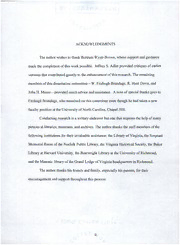
Forgotten Southerner : middle-class associationalism in antebellum Norfolk, Virginia PDF
Preview Forgotten Southerner : middle-class associationalism in antebellum Norfolk, Virginia
THEFORGOTTENSOUTHERNER: MIDDLE-CLASS ASSOCIATIONALISMINANTEBELLUMNORFOLK,VIRGINIA By JOHNGORDONDEAL ADISSERTATIONPRESENTEDTOTHEGRADUATESCHOOL OFTHEUNIVERSITYOFFLORIDAINPARTIALFULFILLMENT OFTHEREQUIREMENTSFORTHEDEGREEOF DOCTOROFPHILOSOPHY UNIVERSITYOFFLORIDA 2003 ACKNOWLEDGMENTS TheauthorwishestothankBertramWyatt-Brown,whosesupportandguidance madethecompletionofthisworkpossible. JeffreyS.Adlerprovidedcritiquesofearlier versionsthatcontributedgreatlytotheenhancementofthisresearch.Theremaining — membersofthisdissertationcommittee W.FitzhughBrundage,R.HuntDavis,and JohnH.Moore—providedmuchadviceandassistance. Anoteofspecialthanksgoesto FitzhughBrundage,whoremainedonthiscommitteeeventhoughhehadtakenanew facultypositionattheUniversityofNorthCarolina,ChapelHill. Conductingresearchisasolitaryendeavorbutonethatrequiresthehelpofmany personsatlibraries,museums,andarchives.Theauthorthanksthestaffmembersofthe followinginstitutionsfortheirinvaluableassistance:theLibraryofVirginia,theSergeant MemorialRoomoftheNorfolkPublicLibrary,theVirginiaHistoricalSociety,theBaker LibraryatHarvardUniversity,theBoatwrightLibraryattheUniversityofRichmond, andtheMasoniclibraryoftheGrandLodgeofVirginiaheadquartersinRichmond. Theauthorthankshisfriendsandfamily,especiallyhisparents,fortheir encouragementandsupportthroughoutthisprocess. n TABLEOFCONTENTS page ACKNOWLEDGMENTS ii LISTOFTABLES iv ABSTRACT v CHAPTER 1 INTRODUCTION 1 2 NORFOLK:THESUNRISECITYBYTHESEA 24 3 BENEVOLENTSOCIETIESINANTEBELLUMNORFOLK 61 4 IMPROVEMENTASSOCIATIONSINANTEBELLUMNORFOLK 87 5 FRATERNALASSOCIATIONSINANTEBELLUMNORFOLK 127 6 CHARACTERISTICSOFASSOCIATIONMEMBERS 166 7 CONCLUSION 200 REFERENCELIST 215 BIOGRAPHICALSKETCH 226 in 1 LISTOFTABLES Table Eage 1 NorfolkPopulationStatistics 58 2 ManufacturedProductsValues(1860)forSouthernCitiesOver10,000 59 3 SouthernPopulationStatisticsfor1860 60 4 NumberofAssociationsJoinedbySample(1845-1854) 191 5 YearsofAssociationMembership(1845-1854) 192 6 AgeCohortsofSample 193 7 NativityofSample 194 8 NumberofChildrenofSampleMembers 195 9 PropertyHoldingWealthofSampleMembers 196 10 SlaveholdingbySampleMembers 197 1 OccupationalCategoriesofSample 198 12 High/lowWhiteCollarandBlueCollarCategories 199 IV AbstractofDissertationPresentedtotheGraduateSchool oftheUniversityofFloridainPartialFulfillmentofthe RequirementsfortheDegreeofDoctorofPhilosophy THEFORGOTTENSOUTHERNER: MIDDLE-CLASS ASSOCIATIONALISMINANTEBELLUMNORFOLK,VIRGINIA By JohnGordonDeal December2003 Chair:BertramWyatt-Brown MajorDepartment:History ThemiddleclassoftheantebellumSouthhasbeenlargelyneglectedinthe scholarlyliterature.Historianshavearguedthatamiddleclassonlyexistedinthe antebellumperiodinlarge,urbanenvironmentssuchasthoseintheNorthwith manufacturinganddiversepopulations.AmiddleclassdoesnotemergeintheSouth,it hasbeentheorized,untilthepostwarNewSoutherawhenmerchants,businessmen,and professionalswrestedpolitical,economic,andsocialpowerawayfromtheplanterelites. Thisstudydemonstratesthatamiddleclasscomprisedofmerchants,proprietors, businessmen,andprofessionalsexistedintheantebellumSouthbyexamining associationalisminthedecadesleadingtotheCivilWarinthesouthernportcityof Norfolk,Virginia. Akeyelementintheprocessofclassformationandidentity,themiddleclassin benevolent,improvement,andfraternalassociationscultivatedandinstilledsharedvalues ofindustry,thrift,sobriety,andpiety,promotedthesebeliefsinothersthroughoutthe community,socializedprospectivemembers,engenderedasenseofcommunityina changingworld,andmadeconnectionswithothersofsimilarbeliefsandbehaviors aroundthecountry. Anexaminationofasampleof400maleassociationmembersfrom 1845to1854illustratesthatorganizationalrosterschieflywerecomposedofanative, married,middle-aged(intheirthirtiesandforties)middleclassofmerchants,proprietors, — andprofessionalswithfamilies,whoownedslaves,andwhopossessedmodest butnot — extreme wealth. Manyjoinedmorethanoneassociation,andmultipleoffice-holding wasprevalent. Organizationleadersalsousedtheseinstitutionstopreparethemfor leadershiprolesinlocalpublicoffices. ThisresearchdemonstratesthatamiddleclassemergedintheantebellumSouth despiteitssmallcities,homogeneouspopulation,commercialeconomicfoundation,and thepresenceofslavery. Althoughanineteenth-centurysouthernmiddleclasswould reachitsapexduringtheNewSouthyears,theiroriginsareseenintheantebellum period. ThefindingsofthisinvestigationultimatelysuggestthatwhiletheNorthand Southhadtheirdifferences,perhapstheysharedmoreculturallythanhaspreviouslybeen theorized. VI CHAPTER 1 INTRODUCTION Whenexaminingthenineteenth-centuryantebellumSouthhistoriansmostoften paintapictureofasocietydividedintosharpdichotomies. Theregionwasnotonly bisectedalongraciallines,butalsoseparatedintermsofclasswherebythewhite communityincludedonlythewealthyplanterelitesandamassofpoverty-stricken whites.1 ThereislittlementionbyscholarsexaminingtheSouthofa"middleclass"of urbanmerchants,professionals,andskilledartisansintheyearsleadinguptotheCivil War. Iftheconceptofasouthernmiddleclassisdiscussedbyhistoriansatallitisinthe contextofapost-CivilWarNewSoutherawhentheyseizedpolitical,economic,and socialhegemonyfromtheplanterelites. Fortheirpart,scholarswhospecializeinexaminingtheemergence,behaviors, andbeliefsystemsofanineteenth-centurymiddleclassneglecttheSouthaswell, preferringinsteadtofocusonthenortheasterncitiesofNewYork,Boston,and Philadelphia,andincreasinglytheMidwestandWest. Thesecitiespossessedtherapid urbanization,industrialization,anddramaticincreasesinpopulation,especiallyasaresult 1SeeforexampleDavidR.Goldfield,CottonFieldsandSkyscrapers,SouthernCityand Region,1607-1980(BatonRouge:LouisianaStateUniversityPress,1982);LawrenceH. Larsen,TheRiseoftheUrbanSouth(Lexington:TheUniversityPressofKentucky, 1985),andLarsen,TheUrbanSouth:AHistory(Lexington:TheUniversityPressof Kentucky,1990). offoreignimmigration,viewedbyhistoriansasbeingcrucialtothedevelopmentofa middleclass. Thisscholarlyneglecthascreatedaneedtoexplorethepresenceofasouthern middleclassthatemergedduringtheantebellumyearsandsubsequentlycontinuedinto thepostwarNewSouthperiod. AmiddleclassdidexistintheSouthdespitethelackof largeanddiverseurbanenvironments,thepresenceofapredominantlycommercialrather thanindustrialeconomicbase,andtheexistenceofslavery,aculturalandeconomic systemantitheticaltothereformminded,free-marketNorth.Theantebellummiddleclass — oftheSouth definedhereasamiddlesocio-economiclayerofmerchant/proprietors, — professionals,andskilledartisans sharedaneconomicnichesituatedbetweenthe aristocraticplanterelitesandpoorwhites. Beyondtheireconomicstatus,theybelievedin thrift,industry,sobriety,andpiety,sharedsimilarconsumerhabits,andparticipatedina cultureofassociationalismthatprovidedameansforthemtorationalizetheir environment,promotetheirvalues,socializeprospectivemembers,engenderasenseof communityinachangingworld,andconnectthemwithlike-mindedpersonsinother areasofthecountry. Thepresentstudywillfocusonthemiddleclassoftheantebellum — — South the"forgottensoutherners" byexaminingassociationalisminthecommercial portcityofNorfolk,Virginia,from1840totheeveoftheCivilWar. Definingtheexistenceofamiddleclass,anddeterminingwhenitemerged,has beenapartofthehistoricalscholarshipfordecades. ConsensushistorianssuchasLouis HartzarguedthattheUnitedStateswasaclasslesssociety,insistingthattheentire countrycomprisedamiddleclasswithoutanaristocracyordestitutelaboringclass. In contrast,historianscomingoutoftheNewSocialHistoryofthe1960sarguedthat economicdifferencesexistedinthesocietythatmanifestedthemselvesnotonlyinterms ofwealth,butalsosociallyandpolitically,thuscreatingdifferentclasses. Thiswas especiallytruewithintheMarxistframeworkinwhichthetwoclassesofeliteownersand laboringworkingclassexistedinconflictwithoneanotheralongadividerelativetothe meansofproduction. AccordingtoMarxisttheoryamiddleclasscouldnotexistasa distinctpermanentclass,butonlyasatemporaryconditionmovingtowardoneofthetwo poles. Extendingaconceptionofclassbeyondeconomicparameters,AnthonyGiddens developedhismodelofstructurationthatallowsformultipleclasslevelsinagiven societytobestructuredalongindicesofmeansofproduction,authority,andpatternsof consumption. Byextensionmembersofaclassnotonlyareconnectedtoeachother(and relatedtoothers)ineconomicterms,butalsothroughbeliefs,experiences,andpatternsof 2LouisHartz,TheLiberalTraditioninAmerica:AnInterpretationofAmericanPolitical ThoughtSincetheRevolution(NewYork:Harcourt,Brace,andCompany,1955),50-64. SeealsoC.WrightMills,WhiteCollar:TheAmericanMiddleClasses(NewYork: OxfordUniversityPress,1956),3-12,63-76. 3SeeDaleL.Johnson,"ClassRelationsandtheMiddleClasses,"inClassandSocial Development:ANewTheoryoftheMiddleClass,ed.DaleL.Johnson(BeverlyHills, California:SagePublications,1982),87-107. relations.4 Giddens'stheoreticalworkallowsnotonlyfortheexistenceofmultiple classesbut,perhapsmoreimportantlyforourpurposes,expandsthepotentialitiesfor unitingtheseclassesbeyondsimplyeconomicrelationsintothemoresubtlerealmof socialrelationsandvaluesystems. Accordingtoprevailingtheoreticalmodels,amiddleclassofmerchants, proprietors,manufacturers,white-collarbusinessmen,andprofessionalemergedduring theantebellumperiodbecauseofaconfluenceofrapidindustrializationandurbanization innortheasterncitieslikeNewYorkandPhiladelphiathatseparatedthosewhohad manualoccupationsfromthosewhoworkedinnon-manualpositions. Broadpatternsof migrationfromthecountrysideandforeignimmigrationintensifiedthisdichotomyof occupation. Thismanifesteditselfintoagrowingeconomicdivergenceintheworkforce assalariedmanagersincreasinglywithdrewfromproductiontosupervisetheworkof wageearnersortodistributethegoodsmadebyothers. Correspondingtothis developmentwasaphysicalseparationinmanualandnon-manualworkenvironments arisingfromthespecializationofduties. Moreover,thecommonworkexperiencesand thepersonalconnectionsthatcouldhavemediatedeconomicandperceivedsocial differenceswerebeingsevered. Increasinglythesemerchants,professionals,clerks,and 4AnthonyGiddens,TheClassStructureoftheAdvancedSocieties(NewYork:Harper andRow,1975),100-12,177-97. ForsimilardiscussionseeStuartM.Blumin,The EmergenceoftheMiddleClass:SocialExperienceintheAmericanCity,1760-1900 (NewYork:CambridgeUniversityPress,1989),8-11;andSvenBeckert,TheMonied Metropolis:NewYorkCityandtheConsolidationoftheAmericanBourgeoisie,1850- 1896(NewYork:CambridgeUniversityPress,2001),347,n.68.
